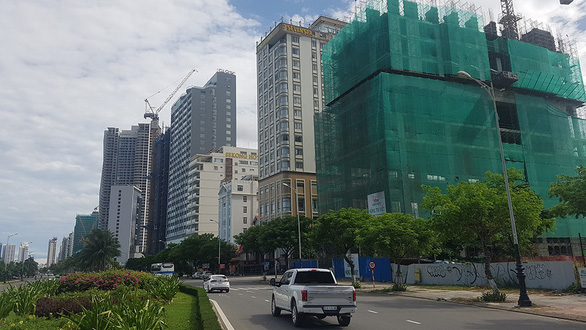An increasing number of towering buildings have been mushrooming along the coastline of Da Nang, which alerts many that they will destroy the cityscape and mount more pressure on local infrastructure.
The topic was brought up during a workshop organized by the Vietnam Association of Architects (VAA) in the central hub on Thursday.
According to Nguyen Cuu Loan, general secretary of the Da Nang urban development association, the city’s tourist industry has flourished over the past decade, opening up many opportunities for shopping and service to expand, especially in such downtown districts as Son Tra and Ngu Hanh Son.
The trend has led to the appearance of high-rise hotels, condotels, restaurants, and apartments along the beachfront.
The problem, according to Loan, is that the infrastructure, including roads and drainage systems, in areas with a high density of tall buildings have not been improved.
“The infrastructure will certainly fail to sustain a large number of users who are apartment tenants, hotel guests and restaurant customers once the buildings are operational,” he elaborated.
A lot of multiple-story buildings are being developed along the Vo Nguyen Giap-Truong Sa route, which is adjacent to the city's famous beaches, namely My Khe, Pham Van Dong, and Non Nuoc, according to the observation of Tuoi Tre (Youth) newspaper reporters.
Luu Duc Hai, vice-president of the Vietnam Urban Planning and Development Association, remarked that the issue does not only confront Da Nang but also other popular beach cities across the country.
There is no doubt these buildings boost the quality of trade and service in tourist hubs, which both residents and visitors can benefit from, Hai stated.
“However, they have blocked the view of the sea, taken away public space, and placed enormous pressure on local infrastructure,” he added.
In order to solve the problem, a scientific study should first be carried out to accurately evaluate the benefits and drawbacks of rapidly building high-rises, the expert stressed.
Beaches belong to the public
Da Nang's development has been rather “reckless” over the past years, negatively impacting biodiversity in both urban and suburban areas, VAA vice-president Nguyen Quoc Thong said at the workshop.
Seaside buildings in the city have created a big ‘wall’ that blocks natural winds and sea views, while creating a lot of challenges for residents and visitors to access the beaches, Thong added.
La Kim Ngan, an official of the VAA, reiterated that beaches are public space and belong to the public.
Such areas have been infringed on by privately-owned restaurants, hotels, and resorts, Ngan continued.
She lauded Da Nang authorities for their recent efforts to reclaim the public space, which has helped sustain the city's development.
Ngo Viet Nam Son, an experienced engineer, aired a similar opinion, suggesting that local authorities have a new vision in their urban planning, which focuses on balancing between the benefits of the public, local residents, and investors.
Like us on Facebook or follow us on Twitter to get the latest news about Vietnam!





















































